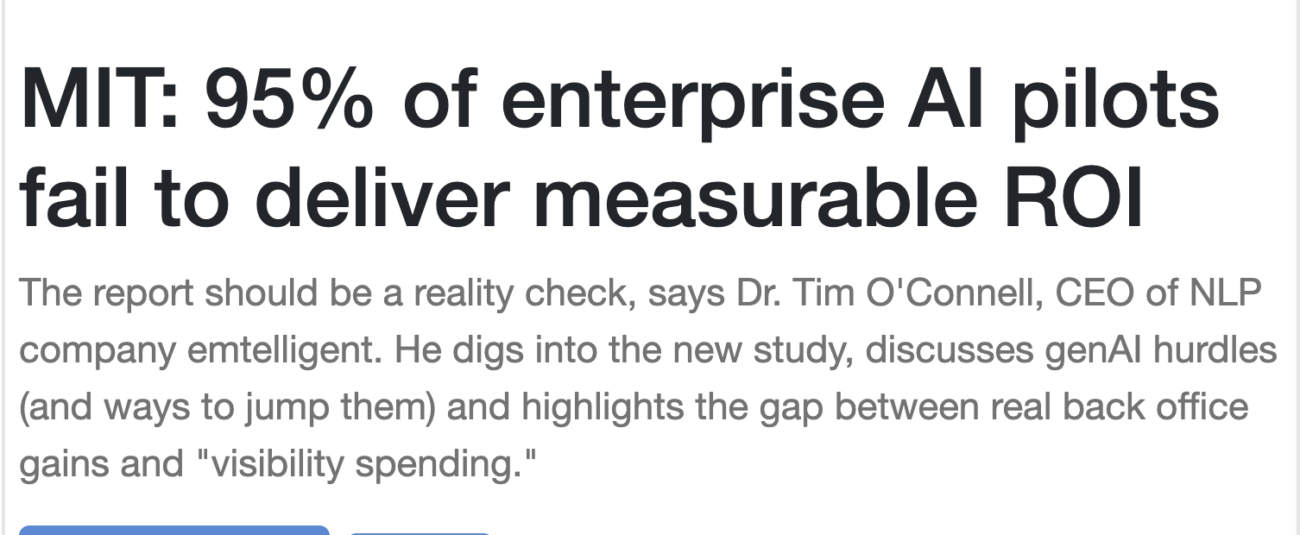In part I of this series, we discussed the massive projected economic gains from AI over the coming years and decades. Given the very bullish projections about AI’s potential future impact and economic upside, many companies, old and new, are plotting to maximize their gains from this powerful technology. The question that I’m tackling here: whether incumbents or the challengers will have the advantage in this competition, has huge implications for the players or would be players in this market. That’s because investing years and millions of dollars building a good AI solution but then not getting the expected traction is hard on the soul. Especially, if the lack of traction is happening because the incumbents are blocking you. Customers will prefer to get these functionalities inside their existing technologies that they’re already using and that provides a leg up for the providers of those systems. If you’re using Salesforce for customer management and agentic AI can automate many of the activities that your team performs inside Salesforce, then it makes sense that the automation would happen inside Salesforce. Given that the foundation models are available to both incumbents and startups and that the incumbents have tons of money and lots of data, what keeps them from building these functionalities inside their products and outcompeting the challengers for those dollars?
This is a foundational question that every startup needs to ask themselves if they’re coming into a space that has a strong system of record like Salesforce, Microsoft Office, and Epic. In healthcare, the EHRs have become the central piece of the workflows inside many hospitals and clinics. It has become almost impossible to get the medical staff to do anything outside of the EHR. As a matter of fact, much of the tech stack within these institutions is now built around the EHR so the care team can view the information they need at the point of care. This includes labs, radiology reports and images, pathology reports, and more. So, if you’re bringing AI that touches on this information, it needs to be able to do it within that system and its output needs to facilitate the workflows in there. This should be easy enough these days given that software systems can be connected to each other using direct connections and Application Programming Interfaces (API.) We’ve had a glimpse of this with AI scribe tools such as Abridge, Ambiance, Suki, and others integrating with Epic so the notes they generate goes straight into the EHR for the doctor to review and sign. Other similar applications for AI coding, prior authorization, sepsis detection, decision support, etc have been developed and integrated into the EHRs or radiology reporting systems. As I said in Part I, it seems like a marriage made in heaven between the incumbents and the startups with cool new AI solutions and the customers being the ultimate winner.
Last month, Epic, the creator of the largest EHR system that has close to 50% of the US lives on it, announced that they’re launching a free AI scribe tool for their customers. That means Epic customers can now choose between a free tool that their EHR provider makes available to them or what the other vendors like Abridge and Ambiance offer. At first glance, it seems like a no-brainer unless there’s significant difference in the performance. That is doubtful since the foundation models that these tools use are available to Epic and fine-tuning those for this use case, writing notes for doctors, is about having access to large quantity of high quality and heterogenous data. Advantage Epic on this! Also, given that Epic has enormous financial resources, recruiting top talent and using all of that data to create a good enough product does not seem beyond their reach.
I ran a health technology company for 6 years, Acupera, and sold population health management software to health systems. This was in the early days of digital health and the technology stack of the medical centers was still work-in-progress (still is, but more developed now.) I repeatedly experienced the desire of the executives at these centers to believe that their EHR vendor could provide them with population health management functionality so they wouldn’t have to buy yet another software system. Not to mention that Epic never made it easy for us to integrate into their system to pull the data we needed to deliver our output. The hassle of integrating these different software systems is one of the key reasons that medical institutions try to avoid buying too many point solutions and prefer their EHR provider, even if they have a slightly inferior product. So, the performance advantage of these systems has to be significant to win against the same functionality offered by the system of record.
In a recent interview with Health IT News, Elizabeth Murumalla, IS project manager at WakeMed Health & Hospitals, discussed their forays into the world of AI tools for their medical institution. She describes a number of use cases such as chart summarization, AI scribe, and sepsis detection tools that they’re rolling out. It is interesting that she named Epic as their strategic partner and the provider of all of these functionalities! She mentioned that while they have resources to do some of the implementation, they are also relying on Epic for the resources they don’t have in-house. This highlights another advantage for the incumbents: the existing working relationship between the two organizations and the fact that since these centers are often short-staffed, they have come to depend on their existing vendors to augment their staff. This comfort level is hard to displace unless the tool you’re providing have significant advantages and the ROI is clear to them.
One of the strategies that point solution companies like those providing AI scribe like Abridge are employing is having multiple functionalities like autonomous coding, prior authorization, claims management, etc to differentiate against Epic’s AI scribe offering. While “land and expand” strategy is an excellent go-to-market strategy and can protect market share and pricing over time, Epic has announced over 160 AI features, including those that these companies are targeting. This is alongside other offerings such as Epic Cosmos, a database that combines data from their customers for knowledge sharing and research. While it will take some time to see how Epic’s features stack up against the more specialized companies, the mere announcement of these coming features will give pause to their customers, similar to what we experienced at Acupera. If Epic and other EHR vendors can deliver good enough features, they will have significant advantages over the startups selling the same features to their customers.

Who will win long-term remains to be seen but if you’re a builder or investor, taking into account incumbency, whether real or not, has to be part of your calculus. Be realistic about the superiority of your product and whether it’s enough to get your customers to sign up with a new vendor. Building products that address workflows outside of the EHR may be a really good idea to avoid this barrier. We’re seeing the same phenomenon outside of healthcare with Google and Microsoft delivering co-pilot functionalities in their email and Office products. It’s hard to imagine that anyone other than them adding these features to their products.





